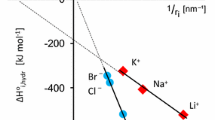Abstract
Starting from a discussion of the grand potential change associated with introduction of ions into water, the electrocaloric effect for the system ion–surrounding water is calculated by means of this recent statistical approach to the problem of water in a high electric field. It is concluded that this effect is essential for the hydration of ions, in particular, for the heat of solution of salts. Consistency between the present approach and recent literature results of a density functionals calculation, as well as experimental data for sequential enthalpies of hydration of doubly charged ions in the gas phase, is discussed.
Similar content being viewed by others
REFERENCES
M. Born, Z. Phys. 1, 45 (1920).
B. M. Pettitt, Theoret. Chem. Account. 103, 171 (2000).
M. Peschke, A. T. Blades, and P. Kebarle, J. Phys. Chem. A 102, 9978 (1998).
M. Pavlov, P. E. M. Siegbahn, and M. Sandström, J. Phys. Chem. A 102, 219 (1998).
J. R. Bontha and P. N. Pintauro, J. Phys. Chem. 96, 7778 (1992).
L. D. Landau and E. M. Lifshits, Statisticheskaya Fizika (Izd. Tekh.-Teor. Lit., Moskva, 1951), Section 25, in Russian; L. D. Landau and E. M. Lifshits, Elektrodinamika Sploshnykh Sred (Izd. Tekh.-Teor. Lit., Moskva, 1957), Sections 12 and 15, in Russian.
H. S. Frank, J. Chem. Phys. 23, 2023 (1955).
G. J. F. Böttcher, O. C. Van Belle, P. Bordevijk, and A. Rip, Theory of Electric Polarization, 2nd revised edn., Vol. 1 (Elsevier, Amsterdam, 1973).
A. Brodsky, Chem. Phys. Lett. 261, 563 (1996).
In-Chul Yeh and M. L. Berkowitz, J. Chem. Phys. 112, 10491 (2000).
Jin-Kee Hyun and T. Ichiye, J. Chem. Phys. 109, 1074 (1998).
Jin-Kee Hyun and T. Ichiye, J. Phys. Chem. B 101, 3596 (1997).
M. F. Toney, J. N. Howard, J. Richer, G. L. Borges, J. G. Gordon, O. R. Melroy, D. G. Wiesler, D. Yee, and L. B. Sorensen, Nature (London) 368, 444 (1994).
I. Danielewicz-Ferchmin and A. R. Ferchmin, J. Phys. Chem. 100, 17281 (1996).
I. Danielewicz-Ferchmin and A. R. Ferchmin, J. Chem. Phys. 109, 2394 (1998).
I. Danielewicz-Ferchmin and A. R. Ferchmin, Physica B 245, 34 (1998).
S. Kielich, Dielectric and Related Molecular Processes, Vol. 1, Chapter 7, M. Davies, Senior Reporter (Chemical Society, Burlington House, London, 1972).
I. Danielewicz-Ferchmin, J. Phys. Chem. 99, 5658 (1995).
. B. P. Nikol'skiy, ed., Spravochnik Khimika, Vol. 1, 3rd corrected edn. (Izd. Khimiya, Leningrad, 1971), p. 1029 (in Russian).
D. Eisenberg and W. Kauzmann, Structure and Properties of Water (Oxford University Press, London, 1969).
C. Kittel, Introduction to Solid State Physics (Wiley, New York, 1966), Chap. 14.
R. C. Weast, ed., Handbook of Chemistry and Physics, 67th edn. (CRC Press, Boca Raton, FL, 1986-1987).
Y. Marcus, Chem. Rev. 88, 1475 (1988).
K. Schäfer, ed., Landolt-Börnstein Numerical Data and Functional Relationships [NS], Vol. 2 (Springer, Berlin, 1976).
H. Ohtaki and T. Radnai, Chem. Rev. 93, 1157 (1993).
A. Habenschuss and F. Spedding, J. Chem. Phys. 70, 3758 (1979).
A. Habenschuss and F. Spedding, J. Chem. Phys. 73, 442 (1980).
S. Romanowski, W. Stasiak, and L. Wojtczak, Electrochim. Acta 27, 511 (1982).
T. Kaneyoshi, Progr. Theoret. Phys. 41, 577 (1969).
T. Kaneyoshi, Progr. Theoret. Phys. 45, 1340 (1971).
D. E. Logan, Y. H. Szczech, and M. A. Tusch, Europhys. Lett. 30, 307 (1995).
G. Hummer, L. R. Pratt, and A. E. García, J. Phys. Chem. 100, 1206 (1996).
C. Satheesan Babu and Carmay Lim, J. Chem. Phys. 114, 889 (2001).
Jin-Kee Hyun, C. Satheesan Babu, and T. Ichiye, J. Phys. Chem. 99, 5187 (1995).
Author information
Authors and Affiliations
Rights and permissions
About this article
Cite this article
Danielewicz-Ferchmin, I., Ferchmin, A.R. Ion Hydration and Large Electrocaloric Effect. Journal of Solution Chemistry 31, 81–96 (2002). https://doi.org/10.1023/A:1014861203174
Issue Date:
DOI: https://doi.org/10.1023/A:1014861203174



